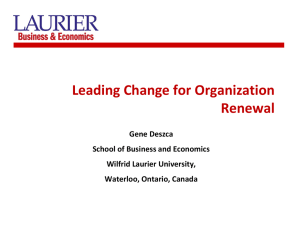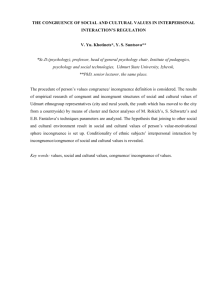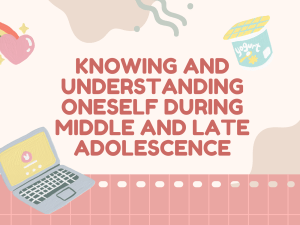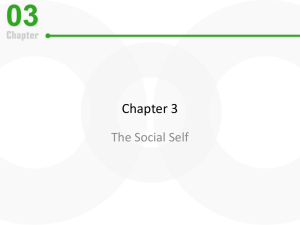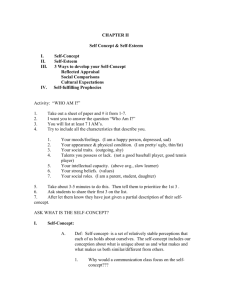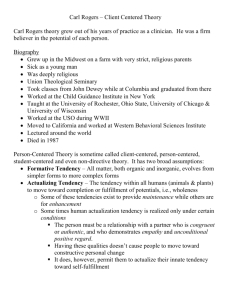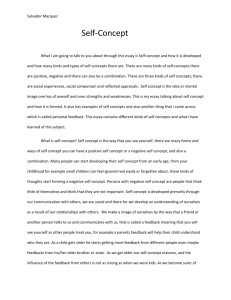File
advertisement
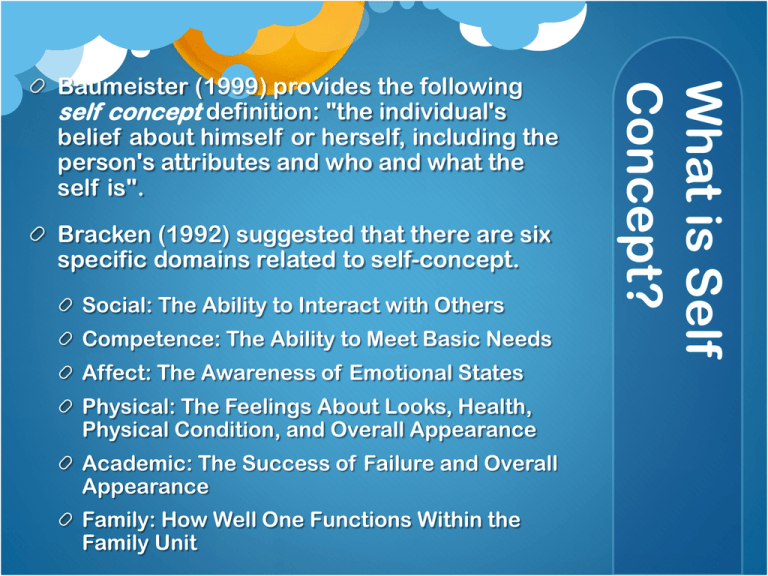
Bracken (1992) suggested that there are six specific domains related to self-concept. Social: The Ability to Interact with Others Competence: The Ability to Meet Basic Needs Affect: The Awareness of Emotional States Physical: The Feelings About Looks, Health, Physical Condition, and Overall Appearance Academic: The Success of Failure and Overall Appearance Family: How Well One Functions Within the Family Unit What is Self Concept? Baumeister (1999) provides the following self concept definition: "the individual's belief about himself or herself, including the person's attributes and who and what the self is". 1. Self Image: How you see yourself. It is important to realize that self-image does not necessarily coincide with reality. People might have an inflated self-image and believe they are better at things than they really are. Conversely, people are also prone to having negative self-images and perceive flaws or weaknesess. Each individual’s self-image is a mix of aspects including physical characteristics, personalities, and social roles. Carl Rogers – 3 Carl Rogers believed Self Concept is broken into three sections. 3. Ideal Self – How you wish you could be. In many cases, the way we see ourselves and how we would like to see ourselves do not match up. 2. Self Esteem This is how much you value yourself. A number of factors can impact self-esteem, including how we compare ourselves to others and how others respond to us. When people respond positively to our behavior, we are more likely to develop positive self-esteem. When we compare ourselves to others and find ourselves lacking it can have a negative impact on our self esteem. Rogers believed that incongruence has its earliest roots in childhood. When parents place conditions on their affection for their children (only expressing love if children "earn it" through certain behaviors and living up to the parents' expectations), children begin to distort the memories of experiences that leave them feeling unworthy of their parents' love. Unconditional love, on the other hand, helps to foster congruence. Children who experience such love feel no need to continually distort their memories in order to believe that other people will love and accept them as they are. Congruence vs. Incongruence According to Carl Rogers, the degree to which a person's self-concept matches up to reality is known as congruence and incongruence. While we all tend to distort reality to a certain degree, congruence occurs when self-concept is fairly well aligned to reality. Incongruence happens when reality does not match up to our self-concept. 1) THE REACTION OF OTHERS. If people admire us, flatter us, seek out our company, listen attentively and agree with us we tend to develop a positive self-image. If they avoid us, neglect us, tell us things about ourselves that we don’t want to hear we develop a negative self-image. 2) COMPARISON WITH OTHERS. If the people we compare ourselves with (our reference group) appear to be more successful, happier, richer, better looking than ourselves we tend to develop a negative self image BUT if they are less successful than us our image will be positive. 3) SOCIAL ROLES. Some social roles carry prestige e.g. doctor, airline pilot, TV. presenter, premiership footballer and this promotes self-esteem. Other roles carry stigma. E.g. prisoner, mental hospital patient, refuse collector or unemployed person. 4) IDENTIFICATION. Roles aren’t just “out there.” They also become part of our personality i.e. we identity with the positions we occupy, the roles we play and the groups we belong to. Arygle (2008) 4 major factors that influence self esteem. Telling children they are good at something when they are in fact not good at it gives them a false sense of security. Once they realize that they are actually not good at the activity, they will lose confidence in other areas as well. Praise – Things that Backfire Inflated praise was defined in this research as an adverb, such as “incredibly”, or an adjective, such as “perfect”, attached to an already positive statement, resulting in an inflated evaluation of a child’s performance. For example, “You’re good at this” is not inflated, whereas “You’re incredibly good at this” is inflated. Lead author of the study, Eddie Brummelman, also discovered that adults gave twice as much inflated praise to children with low selfesteem than to children with high self-esteem.
